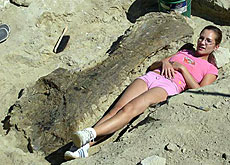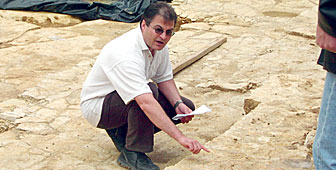Switzerland gets its own Jurassic Park

Thousands of dinosaur footprints have been discovered in the Swiss Jura region, making it one of the world’s biggest track sites.
The prints, which were made as the dinosaurs crossed a Jurassic beach over 150 million years ago, were found in the path of a planned motorway.
“This is one of the most, if not the most, important track sites in the world,” said Wolfgang Hug, head of canton Jura’s palaeontology section.
The footprints first came to light two years ago, during excavations ahead of construction of the new TransJura highway A16.
Hug says that since then about 1,500 dinosaur footprints have been excavated from sites near the village of Courtedoux.
The latest finds were revealed in early August and the geologist expects to find 4,000-5,000 more tracks in the next five to six years.
Scientists have been able to identify two main types of dinosaur – sauropods and therapods – from the prints found in a layer of limestone.
Sauropods were large four-legged herbivores – between 20 and 25 metres tall – with very long necks and tails and elephant-like bodies, while therapods were fierce, meat-eating dinosaurs, which stood on two legs.
Bahamas
Hug and his team know that the dinosaurs lived in a region that looked radically different to the modern day Jura mountain range.
“This region resembled the Bahamas islands today… with large lagoons, and within these, big islands,” Hug said.
The tracks were made as dinosaurs walked across the sand-covered islands. These prints then dried and were covered in a layer of mud.
Over the years more layers were added and these eventually transformed into stone, perfectly preserving the prints.
Hug says that the prints – made by smaller, baby dinosaurs as well as adults – show that dinosaurs were actually living in the region rather than just passing through.
Three different track sites have been discovered, fanning out over a total area of 4,000 metres.
There are 30 specialists working on the sites who perform the various tasks needed to preserve the prints. A track site is first dug out with machines and then painstakingly excavated by hand.
The prints – some as much as one metre across – are then analysed and documented.
Jurassic Park
The discoveries – and the great interest in the area – have prompted the authorities to consider turning the site into a tourist and archaeological attraction.
Hug says the “geopark” would include a museum, which would be built next to the track sites.
He says it is important that the site is preserved for future generations to enjoy.
“The fascination of dinosaurs is that it’s the first time in 150 million years that these tracks have been found,” Hug told swissinfo.
“Nobody has ever seen these tracks and footprints.”
swissinfo, Isobel Leybold-Johnson and Michele Andina
The name “Jurassic” comes from the extensive marine limestone in the Jura Mountains, a region which includes Switzerland, France and Germany.
Palaeontology is the study of developing life on earth, of ancient plants and animals, based on fossils.
Iconology is a branch of palaeontology dealing with fossilised footprints, tracks and burrows.

In compliance with the JTI standards
More: SWI swissinfo.ch certified by the Journalism Trust Initiative













You can find an overview of ongoing debates with our journalists here . Please join us!
If you want to start a conversation about a topic raised in this article or want to report factual errors, email us at english@swissinfo.ch.